 W
W2MASS J12373919+6526148 is a brown dwarf object with late spectral type T in the constellation of Draco, nearly 46 light years away from Sun. The substellar object could likely host a very low-mass companion, possibly in planetary regime.
 W
WAA Tauri is a young variable star in the equatorial constellation of Taurus, located in the Taurus-Auriga star-forming region. It is too faint to view with the naked eye, having an apparent visual magnitude that varies from 12.2 down to 16.1. The star is located approximately 447 light years away from the Sun based on parallax, and is drifting further away with a radial velocity of +17 km/s.
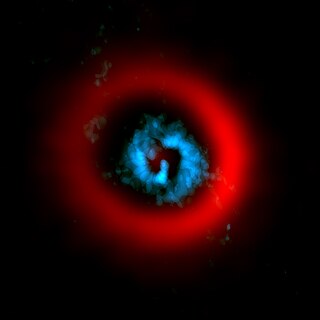 W
WAB Aurigae is a Herbig Ae star in the Auriga constellation. It is known for hosting a dust disk that may harbour a condensing planet or brown dwarf. The star could host a possible substellar companion in wide orbit. The star is part of the young Taurus-Auriga association, which is located in the Taurus Molecular Cloud.
 W
WAldebaran, designated α Tauri, is a giant star measured to be about 65 light-years from the Sun in the zodiac constellation Taurus. It is the brightest star in Taurus and generally the fourteenth-brightest star in the night sky, though it varies slowly in brightness between magnitude 0.75 and 0.95. Aldebaran is believed to host a planet several times the mass of Jupiter, named Aldebaran b.
 W
WArcturus, designation α Boötis, is the brightest star in the constellation of Boötes, the fourth-brightest in the night sky, and the brightest in the northern celestial hemisphere. Together with Spica and Denebola, Arcturus is part of the Spring Triangle asterism and, by extension, also of the Great Diamond along with the star Cor Caroli. When viewed from Earth, it appears to be positioned almost at the north galactic pole of the Milky Way.
 W
WBeta Hydri is a star in the southern circumpolar constellation of Hydrus. With an apparent visual magnitude of 2.8, this is the brightest star in the constellation. Based upon parallax measurements the distance to this star is about 24.33 light-years.
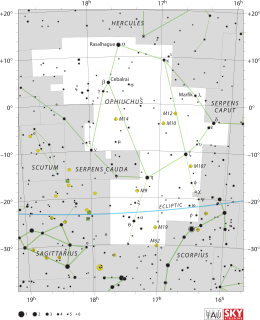 W
WBeta Ophiuchi, also named Cebalrai, is a star in the equatorial constellation of Ophiuchus. The apparent visual magnitude of this star is 2.7, which is readily visible to the naked eye even from urban skies. The distance to this star can be estimated using parallax measurements, yielding a value of 81.8 light-years from the Sun.
 W
WCVSO 30 is a binary T Tauri star, located in constellation Orion at 1200 light years from Earth away with two candidate planets. Both candidate planets are gas giants. It is the first star around which potential planets have been found both by the transit method and by direct imaging.
 W
WDQ Herculis, or Nova Herculis 1934, was a slow, bright nova occurring in the northern constellation of Hercules in December 1934. This cataclysmic variable star was discovered on 13 December 1934 by J. P. M. Prentice from Stowmarket, Suffolk. It reached peak brightness on 22 December 1934 with an apparent magnitude of 1.5. The nova remained visible to the naked eye for several months.
 W
WEta Cephei is a star in the northern circumpolar constellation of Cepheus. It shares the name Al Kidr with θ Cep, although the meaning of this name is unknown. With an apparent visual magnitude of 3.4, this is a third magnitude star that, according to the Bortle Dark-Sky Scale, is readily visible to the naked eye. Parallax measurements put it at a distance of 46.53 light-years from Earth.
 W
WFomalhaut, designation Alpha Piscis Austrini is the brightest star in the constellation of Piscis Austrinus, the "Southern Fish", and one of the brightest stars in the sky. It is a class A star on the main sequence approximately 25 light-years (7.7 pc) from the Sun as measured by the Hipparcos astrometry satellite. Since 1943, the spectrum of this star has served as one of the stable anchor points by which other stars are classified. It is classified as a Vega-like star that emits excess infrared radiation, indicating it is surrounded by a circumstellar disk. Fomalhaut, K-type main-sequence star TW Piscis Austrini, and M-type, red dwarf star LP 876-10 constitute a triple system, even though the companions are separated by approximately 8 degrees.
 W
WGamma Delphini, Latinized from γ Delphini, is a binary star system approximately 101 light-years away in the constellation of Delphinus. The star marks one corner of the asterism "Job's Coffin". It is one of the best known double stars in the sky, consisting of a fourth magnitude orange subgiant and a fifth magnitude yellow-white dwarf.
 W
WGJ 1151 is a star located in the northern circumpolar constellation of Ursa Major at a distance of 26.2 light years from the Sun. It has a reddish hue and is too faint to be visible to the naked eye with an apparent visual magnitude of 14.0 The star is moving closer with a radial velocity of −36 km/s, and has a relatively large proper motion, traversing the celestial sphere at a rate of 1.815″·yr−1.
 W
WHD 131399 is a star system in the constellation of Centaurus. Based on the system's electromagnetic spectrum, it is located around 351 light-years away. The total apparent magnitude is 7.07, but because of interstellar dust between it and the Earth, it appears 0.22 ± 0.09 magnitudes dimmer than it should be.
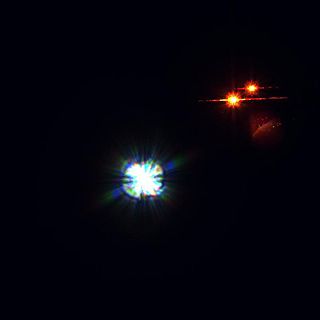 W
WHD 141569 is an isolated Herbig Ae/Be star of spectral class A2Ve approximately 320 light-years away in the constellation of Libra. The primary star has two red dwarf companions at about nine arcseconds. In 1999, a protoplanetary disk was discovered around the star. A gap in the disk speculate a possible extrasolar planet forming in the disk.
 W
WHD 149382 is a star in the constellation of Ophiuchus with an apparent visual magnitude of 8.943. This is too faint to be seen with the naked eye even under ideal conditions, although it can be viewed with a small telescope. Based upon parallax measurements, this star is located at a distance of about 240 light-years from the Earth.
 W
WHD 172555 is a white-hot A7V star located relatively close by, 95 light years from Earth in the direction of the constellation Pavo. Spectrographic evidence indicates a relatively recent collision between two planet-sized bodies that destroyed the smaller of the two, which had been at least the size of Earth's moon, and severely damaged the larger one, which was at least the size of Mercury. Evidence of the collision was detected by NASA's Spitzer Space Telescope.
 W
WIota Aurigae, officially named Hassaleh, is a star in the northern constellation of Auriga. It has an apparent visual magnitude of 2.7, which is bright enough to be readily visible to the naked eye. Parallax measurements give a distance estimate of roughly 490 light-years from the Sun.
 W
WPi Herculis is a third-magnitude star in the constellation Hercules. As one of the four stars in the Keystone asterism, it is one of the constellation's more easily recognized. It has an apparent visual magnitude of +3.2, which is visible to the naked eye and makes it one of its brighter members. The Hipparcos satellite mission estimated its distance at roughly 115 parsecs from Earth, or about 377 light years away. The overall reduction in the star's visual magnitude due to extinction from the intervening matter is 0.11.
 W
WPSR B1937+21 is a pulsar located in the constellation Vulpecula a few degrees in the sky away from the first discovered pulsar, PSR B1919+21. The name PSR B1937+21 is derived from the word "pulsar" and the declination and right ascension at which it is located, with the "B" indicating that the coordinates are for the 1950.0 epoch. PSR B1937+21 was discovered in 1982 by Don Backer, Shri Kulkarni, Carl Heiles, Michael Davis, and Miller Goss.
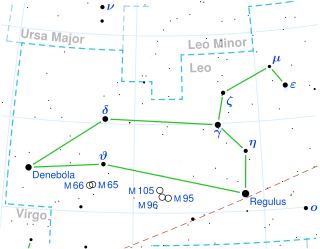 W
WR Leonis is a red giant Mira-type variable star located approximately 370 light years away in the constellation Leo.
 W
WRT Andromedae is a variable star in the constellation of Andromeda. The system is estimated to be 322 light-years away.
 W
WTheta Cygni is a star in the northern constellation of Cygnus. It has an apparent visual magnitude of 4.5, so it can be seen from the northern hemisphere with the naked eye in sufficiently dark skies. Based upon parallax measurements, it is at a distance of about 59.8 light-years from the Earth. It is suspected of hosting an extrasolar planet.
 W
WTVLM 513-46546 is an M9 ultracool dwarf at the red dwarf/brown dwarf mass boundary in the constellation Boötes. It exhibits flare star activity, which is most pronounced at radio wavelengths. The star has a mass approximately 80 times the mass of Jupiter. The radio emission is broadband and highly circularly polarized, similar to planetary auroral radio emissions. The radio emission is periodic, with bursts emitted every 7054 s, with nearly one hundredth of a second precision. Subtle variations in the radio pulses could suggest that the ultracool dwarf rotates faster at the equator than the poles in a manner similar to the Sun.
 W
WTW Hydrae is a T Tauri star approximately 196 light-years away in the constellation of Hydra. The star is the closest such star to the Solar System. TW Hydrae is about 80% of the mass of the Sun, but is only about 5-10 million years old. The star appears to be accreting from a face-on protoplanetary disk of dust and gas, which has been resolved in images from the ALMA observatory. TW Hydrae is accompanied by about twenty other low-mass stars with similar ages and spatial motions, comprising the "TW Hydrae association" or TWA, one of the closest regions of recent "fossil" star-formation to the Sun.
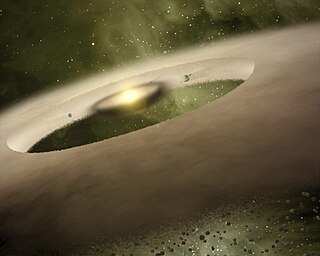 W
WUX Tauri, abbreviated as UX Tau, is a binary star system approximately 450 light-years away in the constellation of Taurus. It is notable for the fact that, despite its recent creation, the Spitzer Space Telescope discovered that its protoplanetary disk contains a gap. The dust, which normally accumulates in an expanding ring starting right next to the star at such a young age, is either very thin or nonexistent at a range of 0.2 to 56 AU from the star. Typically, this means that the early ancestors of planets may be forming from the disk, though the star only ignited about 1 million years ago. In contrast, Earth was formed approximately 4.54 billion years ago, placing its formation about sixty million years after the Sun's ignition around 4.6 billion years ago.
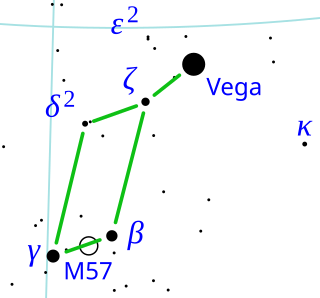 W
WVega is the brightest star in the northern constellation of Lyra. It has the Bayer designation α Lyrae, which is Latinised to Alpha Lyrae and abbreviated Alpha Lyr or α Lyr. This star is relatively close at only 25 light-years from the Sun, and, together with Arcturus and Sirius, one of the most luminous stars in the Sun's neighborhood. It is the fifth-brightest star in the night sky, and the second-brightest star in the northern celestial hemisphere, after Arcturus.
 W
WWD J0914+1914 is the first single white dwarf star found to have a giant planet orbiting it. Evidence of the giant planet was discovered by a team of astronomers from the UK, Chile and Germany.